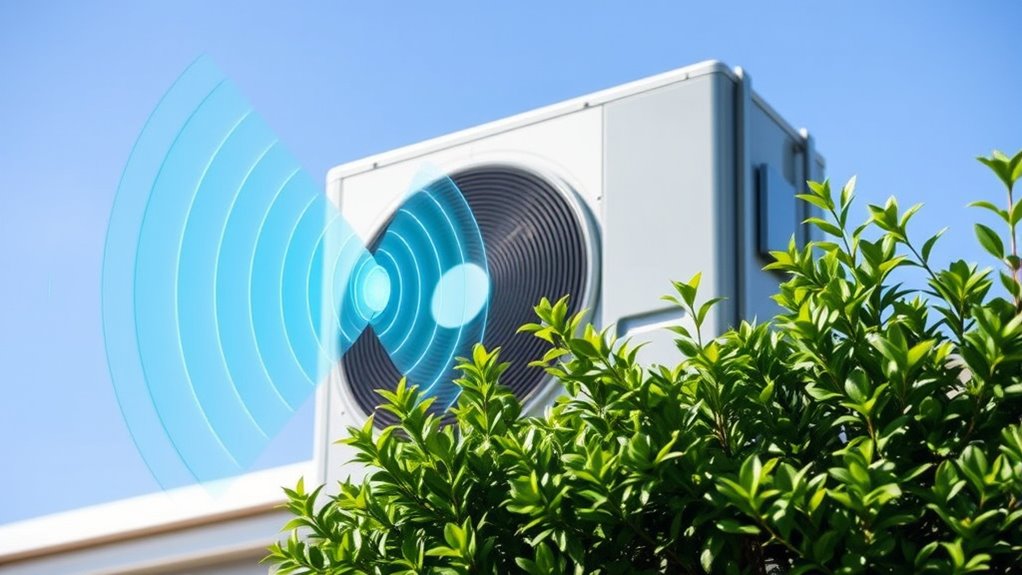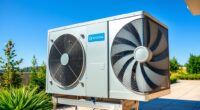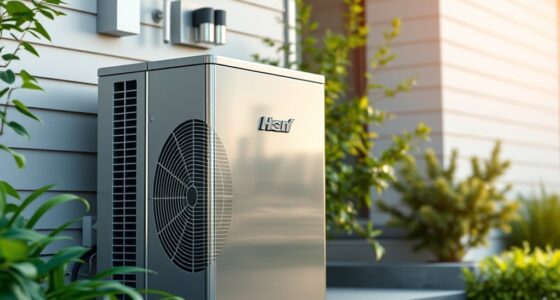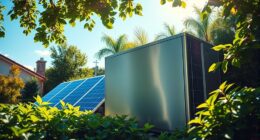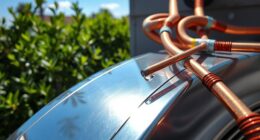When your heat pump cools, noise levels usually range from 40 to 60 decibels, depending on the model and installation. Outdoor units with sound-insulating features or inverter technology tend to be quieter, often around 40-50 dB. Factors like positioning, maintenance, and unit design influence the noise you hear. If you want to understand how different models compare and tips to reduce noise, keep exploring the details ahead.
Key Takeaways
- Typical noise levels range from 40 to 60 dB at one meter, depending on the model and features.
- Modern quiet models with sound insulation and inverter technology often operate around 40-50 dB.
- Placement and environmental factors significantly influence perceived noise during operation.
- Ductless mini-split units generally produce quieter noise levels, usually between 40-50 dB.
- Unusual or loud noises may indicate mechanical issues or installation problems needing professional inspection.
Typical Noise Emissions From Cooling Heat Pumps
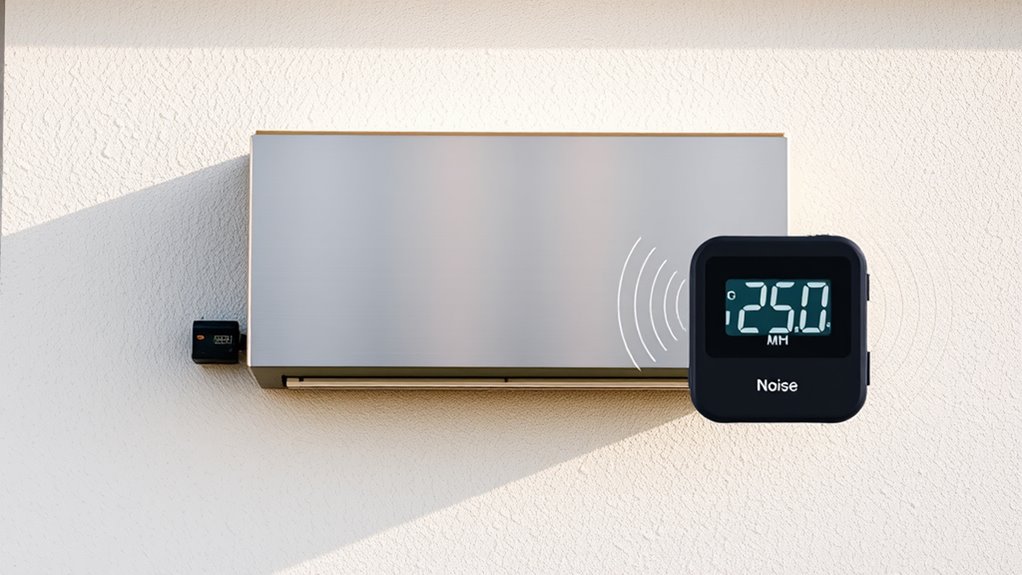
Have you ever wondered how loud a cooling heat pump typically is? Most models produce noise levels between 40 and 60 decibels (dB) at one meter. The main sources are the outdoor fan, compressor, and the sounds of refrigerant flowing. Modern heat pumps are designed for quiet operation, often featuring low-noise fans and sound insulation, bringing noise levels down to around 40-50 dB—similar to a library. The noise emitted depends on the unit’s design; slim-profile or inverter models tend to operate more quietly. Outdoor noise mainly results from air moving through the fan blades and compressor activity. If you experience excessive or unusual noise during cooling, it might signal noise issues or installation problems that need professional inspection. Additionally, sound insulation in the unit’s construction can significantly reduce noise levels, enhancing comfort.
Factors That Affect Noise Levels During Cooling
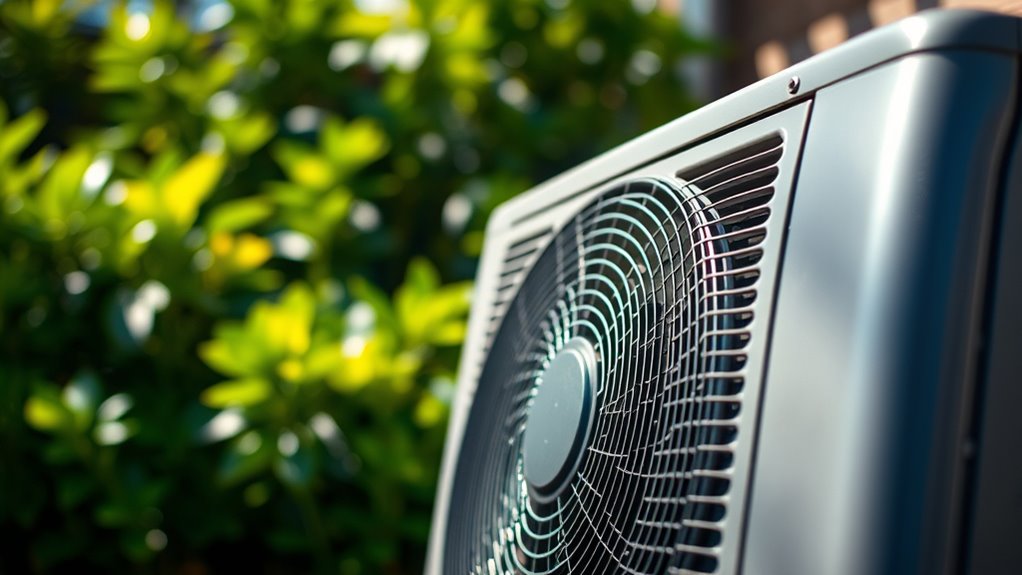
Several factors influence the noise levels you experience during cooling, and understanding them can help you minimize disruptions. The placement of your outdoor unit is key—position it away from windows and outdoor living spaces to reduce perceived noise. The design and size of fan blades also matter; larger, slower-spinning fans produce less noise. Environmental factors like reflective surfaces or echo-prone areas can amplify sound, so consider landscaping or sound barriers. Poor maintenance, such as dirty filters or unbalanced fan blades, increases noise, while choosing a model with advanced technological features like sound-insulating components or inverter compressors can lower noise levels. Additionally, modern heat pumps often incorporate specialized noise-reduction technology, which can further decrease operational sound during cooling. Advances in soundproofing techniques continue to enhance the quiet operation of these systems, making them more comfortable for users. Regular servicing and proper installation are crucial in maintaining low noise levels and ensuring optimal performance. Proper system design can also play a significant role in reducing noise emissions. Moreover, selecting units with variable-speed motors can significantly reduce noise by allowing the system to operate at lower, quieter settings. Keep in mind, the combination of these factors determines how many decibels (dB) your heat pump emits during cooling, affecting overall comfort.
Comparing Noise Levels of Different Heat Pump Models
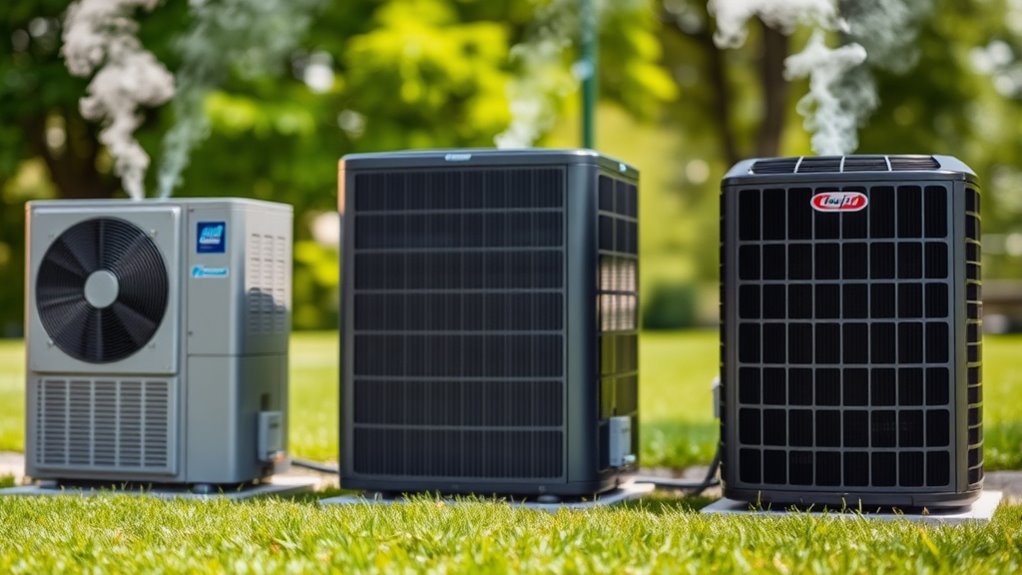
When comparing different heat pump models, noise levels can vary substantially, influencing your comfort and outdoor environment. Heat pump noise levels during cooling mode range from about 40 dB in quieter models to over 70 dB in louder units. Ductless mini-split heat pumps, especially slim-profile outdoor units, typically operate between 40-50 dB, making them much quieter than traditional box-shaped units. Modern units with sound insulation, larger fans, and advanced compressor technology can noticeably reduce noise, often reaching 43-50 dB. Inverter technology and noise reduction features further lower sound levels during operation. When choosing, compare sound levels in decibels and consider outdoor unit noise, as these factors impact your comfort, especially if your heat pump has sound insulation and noise control features built in. Additionally, self watering plant pots are designed to maintain consistent moisture levels, reducing the need for frequent watering and helping to prevent overwatering issues.
Strategies to Reduce Noise During Cooling Operation
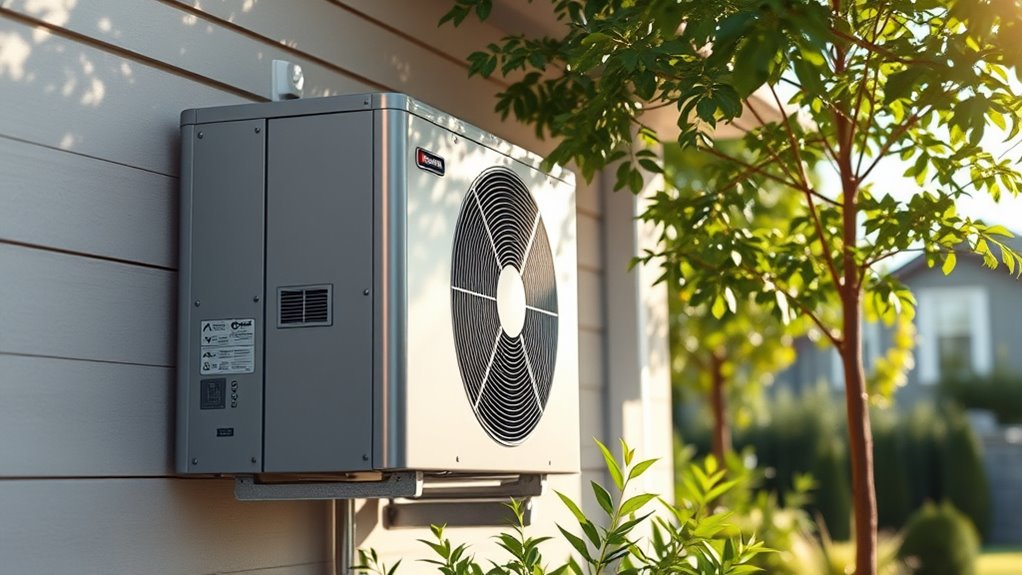
Reducing noise during cooling operation is achievable through simple but effective strategies that you can implement around your outdoor unit. First, ensure proper placement by situating your outdoor unit away from windows and outdoor living spaces to decrease perceived sound levels. Second, install anti-vibration mounts and sound-dampening pads beneath the unit to minimize vibrations and rattling sounds. Third, choose models with larger, slower fan blades, which produce less noise during airflow, lowering decibels (dB). Additionally, regular maintenance like cleaning fan blades and tightening loose parts prevents noise caused by debris or mechanical wear. Proper installation techniques can further enhance noise reduction and unit efficiency. Regularly inspecting and maintaining your heat pump can also prevent mechanical issues that contribute to increased noise levels. Furthermore, selecting units with advanced noise reduction features can significantly decrease operational sound. Incorporating soundproofing methods around the unit, such as acoustic panels or barriers, can further dampen noise transmission. Moreover, understanding the security implications of noise levels can help you choose the most suitable equipment to ensure both comfort and safety. Finally, strategic landscaping with shrubs or fences can absorb or block sound, further reducing noise during the cooling operation. These steps help you achieve a quieter outdoor environment and improve comfort.
Recognizing Unusual or Excessive Noise in Cooling Mode

Unusual or excessive noise during cooling operation often signals that something isn’t functioning properly. You might notice buzzing or abnormal sounds that go beyond the typical hum of 40-60 dB, which could indicate issues like refrigerant flow problems or refrigerant leaks. Persistent vibration, rattling, or grinding sounds suggest loose parts or compressor issues, especially if combined with reduced cooling efficiency. Loud banging or squealing may point to system irregularities or worn-out components in the outdoor unit. Sudden increases in noise levels often signal refrigerant leaks or compressor trouble, while swooshing or gurgling sounds can indicate refrigerant flow irregularities or trapped air. Recognizing these signs early helps prevent further damage and keeps your heat pump operating smoothly. Additionally, understanding the importance of system maintenance can help prevent many of these noise issues from developing. Regular inspections and preventive care ensure that components remain in good condition, reducing the likelihood of noise-related problems. Proper system tuning can also optimize performance and minimize unwanted sounds during operation.
Frequently Asked Questions
What Is an Acceptable Noise Level for a Heat Pump?
You probably wonder what noise level is acceptable for a heat pump. Generally, a noise range of 40 to 55 decibels works well, similar to a quiet conversation. Modern low-noise models stay within this range, making them unobtrusive in residential areas. Anything above 60 dB might be disturbing, especially near bedrooms. Keep in mind, staying below 55 dB is ideal for comfort and harmony with your outdoor environment.
Do Heat Pumps Make More Noise in Cold Weather?
Think of your heat pump as a loyal guardian, steady in all seasons. In cold weather, it might work a bit harder, similar to an athlete training in tougher conditions. This can cause slight increases in noise, especially during the defrost cycle or when the compressor runs longer. However, modern inverter models often keep noise levels low, ensuring your comfort without disturbing the peace, no matter the temperature outside.
What Are the Sound Ratings for Heat Pumps?
You’re wondering about the sound ratings for heat pumps. Generally, they produce between 40 and 60 decibels, with modern inverter models often quieter, closer to 40-50 dB. Ductless mini-splits are especially quiet, similar to a conversation. Higher noise levels, around 60 dB, match a refrigerator or background office noise. Check manufacturer datasheets or Energy Star labels for specific ratings on individual units.
Which Heat Pump Is the Quietest?
Imagine a whispering breeze guiding you through a tranquil forest—that’s the silence you seek. When choosing the quietest heat pump, look for inverter-driven models from top brands like Mitsubishi or Daikin. These units act like stealthy shadows, operating at around 43 to 45 decibels. Their slim profiles, sound insulation, and anti-vibration features make them nearly invisible, ensuring peaceful comfort without disrupting your sanctuary.
Conclusion
Understanding the noise levels of your heat pump in cooling mode helps you enjoy comfort without the unwanted symphony of sound. By considering factors that influence noise, comparing models, and employing noise-reduction strategies, you can keep your environment peaceful. Think of your heat pump as a gentle breeze rather than a roaring storm—balancing efficiency with serenity. With awareness and proper choices, you’ll ensure your cooling system remains a quiet, welcomed presence in your home.
